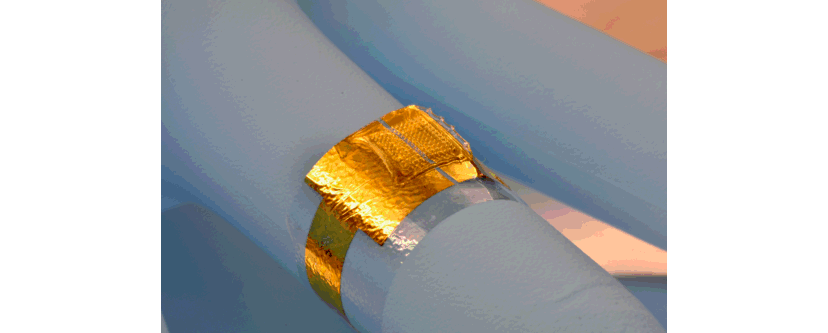March 8, 2021
(LOS ANGELES) – Recent advances in technology have opened many possibilities for using wearable and implantable sensors to monitor various indicators of patient health. Wearable pressure sensors are designed to respond to very small changes in bodily pressure, so that physical functions such as pulse rate, blood pressure, breathing rates and even subtle changes in vocal cord vibrations can be monitored in real time with a high degree of sensitivity.
Such responses occur when a substance in the sensor “gates,” or allows selected pressure signals to pass to a transistor, which then conducts and amplifies these signals for detection. A recent type of transistor, organic electrochemical transistors (OECTs), has exhibited superior signal amplification capabilities at lower voltages and power consumption. However, there has been little exploration of OECTs for use in pressure sensors because they are usually paired with liquid gating substances, which do not respond well to external pressure.
A collaborative team from the Terasaki Institute for Biomedical Innovation (TIBI) has found ways to solve this problem in order to develop soft OECTs for wearable pressure sensors. They first experimented with a solid type of gating substance – a charged, gelatinous substance called an ionic hydrogel. Due to the physical characteristics of this gel, they were successfully able to demonstrate improved pressure sensing when they used it together with OECTs.
The team then took this finding a step further by fabricating ionic hydrogels with tiny pyramidal microstructures which helped to increase the pressure sensitivity that could be measured. “The deformity of the hydrogel microstructures in response to applied pressure increases the capacitance change at the gate electrodes,” explained Yangzhi Zhu, Ph.D., part of the TIBI team. “This enhances the ability to detect very subtle pressure signals.”
The team also found that the microstructured hydrogel allowed them to obtain higher pressure sensitivity that could be adjusted by changing the applied gate voltage. Furthermore, this optimized sensor could operate at low operation voltage and low power consumption. These features combine to make a high-performing pressure sensor that is economical, long-lasting andenergy efficient – clear advantages for devices that are intended to collect long-term, real-time data. “Low cost, low power-consumption, and high sensitivity are inherent advantages of OECTs. Here we, for the first time, demonstrate the use of OECTs for pressure sensing applications by using a soft hydrogel as a gating medium,” said Shiming Zhang, Ph.D., TIBI’s affiliated faculty member who is an assistant professor in the Department of Electrical and Electronic Engineering and The University of Hong Kong. “It opens new opportunities for OECTs towards future in vivo pressure sensing applications.”
“Having an energy-efficient, long-lasting pressure sensing device is a real asset for patients who need long-term monitoring, and it facilitates the ability to self-monitor at home,” said Ali Khademhosseini, Ph.D., TIBI’s director and CEO. “The advances gained here in pressure sensor development are one of many examples of the work that we do to enhance patient health.”
Additional authors are Xiaochen Wang, Xiang Meng, Haonan Ling, Yihang Chen, Zhikang Li, Martin C. Hartel, Mehmet R. Dokmeci, Shiming Zhang and Ali Khademhosseini.
This work was supported by the National Institutes of Health under Grant 1R01GM126571-01.

